| |
|
|
CARDINAL MEADOWHAWK
Sympetrum illotum
|
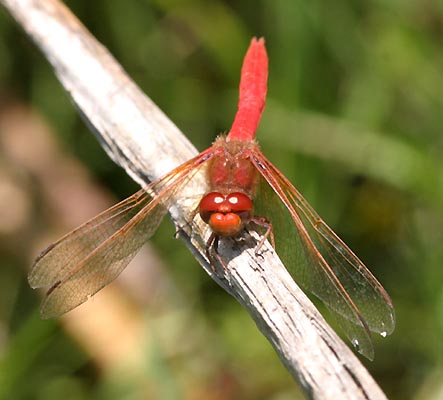 |
photo (above) 2
Aug 2006 Laguna Grande,
Seaside
|
Cardinal Meadowhawk is the common red-bodied
meadowhawk in Monterey
County. Males perch low over or adjacent to still or slow-moving water
at ponds, canals, and small open streams. The eyes are red to go with
an
orange-red face, and they often perch expectantly, wings bowed forward,
ready to launch at any moment.
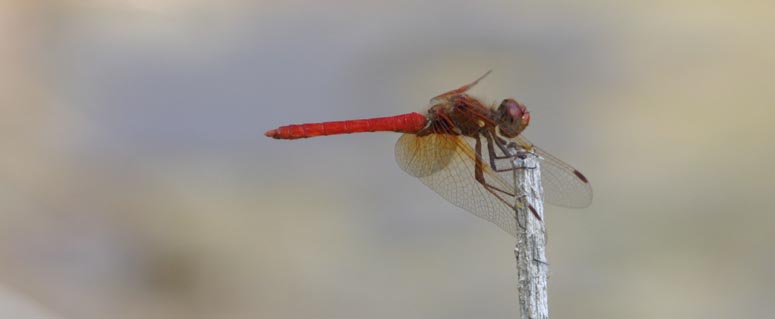
photo (above) 24
July 2006 Laguna Grande
photos (below, male & female) 2
Aug 2006 Laguna Grande
|
| Here are a male and a female in similar
poses. Both sexes have uniformly
colored abdomens: all-red in the males and all-brown in females. There
are a number of other species of meadowhawks with red abdomens,
including
Red-veined which is rare here, but Variegated Meadowhawk has a pattern
of colored dots on the abdomen. Note the orange wash to the base of the
wings, more apparent on the male, that includes not only the forewing
but
also washes across the base of hind portion of each wing. |
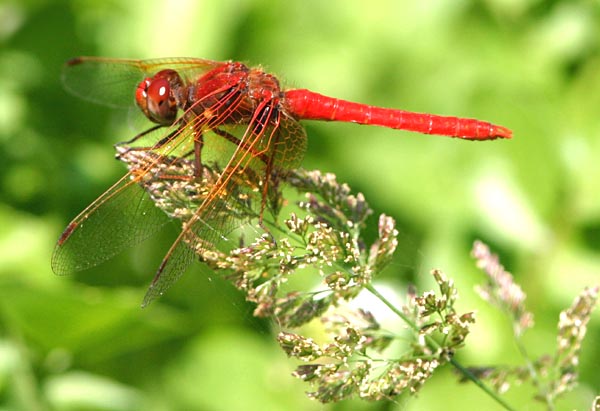
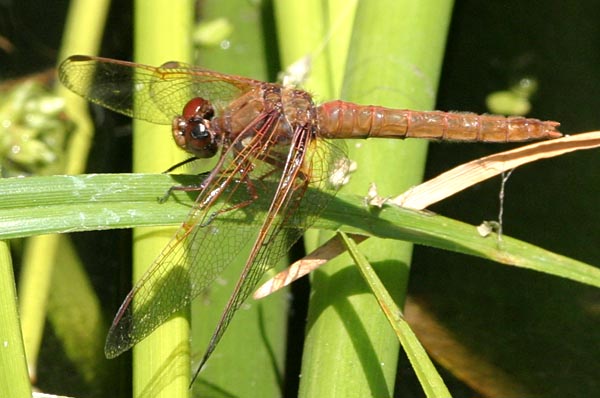 |
|
When a female visits the male's territory, he
chases her down for copulation
and ten ovipositing. The photo below shows a pair in tandem, with the
female
ovipositing by tapping the surface of the rivulet rapidly.
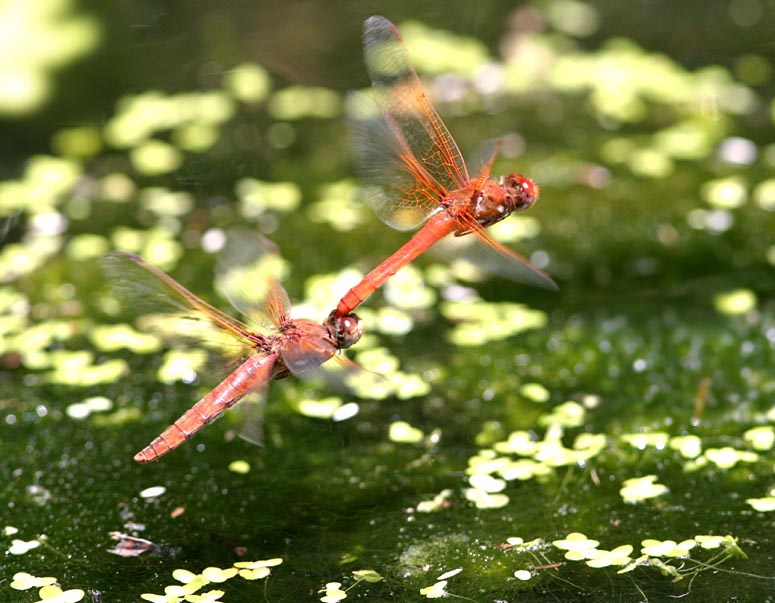
photo (above) 2
Aug 2006 Laguna Grande
photo (below) 19 July 2006 Laguna
Grande
|
|
With good views, a good character on both
sexes is the presence
of two white elongated spots on the thorax. See how apparent they can
be
on this photo of a male (below). These spots are often hidden by the
wings,
especially when the wings are held forward, but their presence will
rule
out the possibility of something much rarer.
|
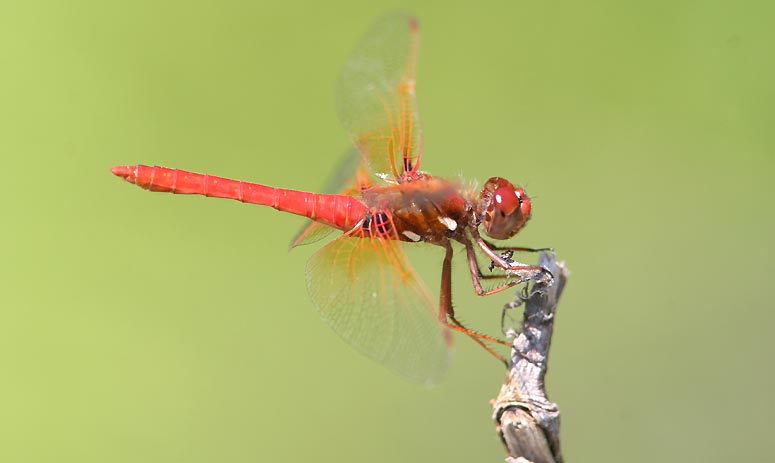
|
|
Sometimes, as in the view below, the wings
are held far forward
and obscure the thorax and the face.
|
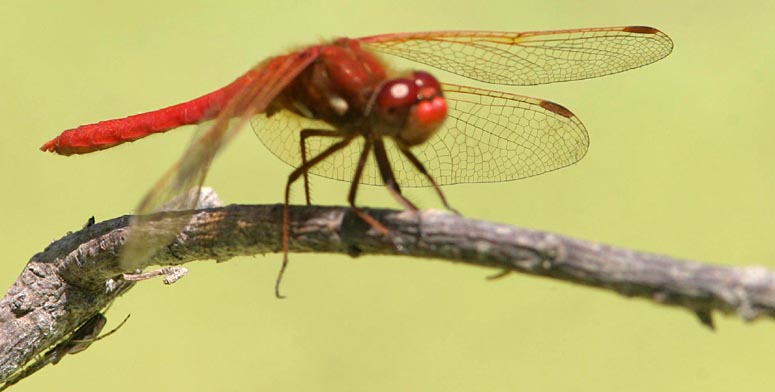
photo (above) 19
July 2006 Laguna Grande
|
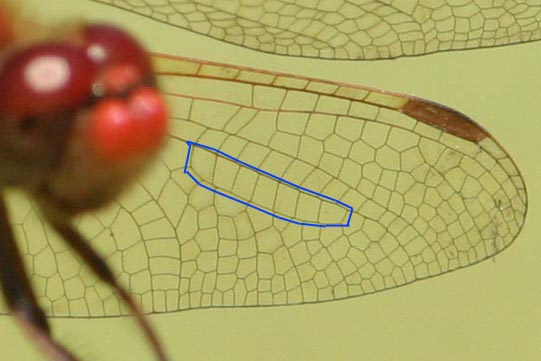 |
But we'll use this view to illustrate
another point. Look at the set
of cells in the wing venation that are outlined in blue. These are the
cells between the radial sector and the radial planate, and in this
species
[Cardinal Meadowhawk] there is just a single row of cells. On
Red-veined
Meadowhawk S. madidum, much rarer in MTY, the middle part of
the
outlined set of cells have a two rows of cells. This, and other i.d.
characters,
are discussed in more detail in Manolis (2003). |
|
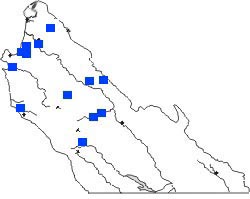 This
map shows a selection of known sites where the species has been
recorded
in MTY. It is likely present, in season, in suitable habitat anywhere
in
the county. In California, although primarily a foothill species, it
has
been found upslope to 7000' elevation. In MTY, this ode has been found
at ponds and streams in the lowlands and foothills, but has also been
collected
at 5000' elev on Chews Ridge (30 June 1974; Rosser W. Garrison). This
map shows a selection of known sites where the species has been
recorded
in MTY. It is likely present, in season, in suitable habitat anywhere
in
the county. In California, although primarily a foothill species, it
has
been found upslope to 7000' elevation. In MTY, this ode has been found
at ponds and streams in the lowlands and foothills, but has also been
collected
at 5000' elev on Chews Ridge (30 June 1974; Rosser W. Garrison).
MTY flight dates range from at least 26
Mar–25 Oct; the peak seems to
be about May-September. There is one unseasonal winter record – 4 Feb
2003
CSUMB, Ft. Ord (collected by R.J. Adams) – that could be a "late" date
rather than an actual first emerger in spring. Or not; it is hard to
say. Elsewhere in California the
flight
season is generally March-October, although there are scattered winter
records from southern California (Manolis 2003).
|
|
|
Literature cited:
- Manolis, T. 2003. Dragonflies and Damselflies of
California. Univ. of
Calif.
Press, Berkeley.
Web resources:
Major identification web sites with much information on California
odes include:
For sites with excellent photos to compare for identification or to
simply
enjoy, see:
Many of these sites have links to other useful pages. Kathy Biggs's
site
is particularly useful in her selection of links. |
|
All photos © Don Roberson 2007
TOP
|
|
|
Page created 14 Aug 2006, updated 16 May 2007
|
|
|
|
|
